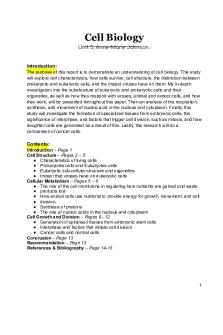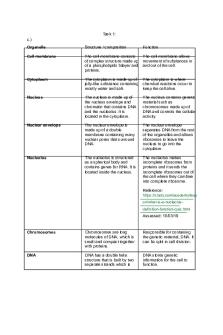Unit 1 Cell Biology - notes PDF

| Title | Unit 1 Cell Biology - notes |
|---|---|
| Course | Intro Cell Biology |
| Institution | University of Waterloo |
| Pages | 5 |
| File Size | 134.7 KB |
| File Type | |
| Total Downloads | 35 |
| Total Views | 166 |
Summary
notes...
Description
UNIT 1: INTRODUCTION TO THE CELL BIO 130 NOTES Glory Widjaja - cell: small, membrane-closed units filled with a concentrated (aq) solution of chemicals able to replicate HISTORY & SCIENTISTS 1) Robert Hooke - first microscope viewing slices of cellula (cork), looked like empty rooms 2) Antoni Van Leeuwenhoek - glass microscope = 300x magnification viewed... → Protists from pond water → Bacteria (mouth), "father microbiology" → Parasites in feces → Blood cells → Banded pattern of muscle cells → Sperm Issues of the Time: - emphasis on description rather than explanation due to limited resolving power Breakthrough (1830's): - compound microscope! - magnification AND resolution - objects less than 1 micrometer PICTURE THIS: What is Viewable at What Distance ions = smallest, seen with electron microscope eggs/ocyetes = largest cell *overlap between organelle and cells @ light microscope* Beginning of Cell Theory: 3) Robert Brown (botanist) - every plant cell had round "kernel" = nucleus 4) Matthias Schleiden - all plant tissues composed of smaller cells - embryonic plant always arose from single cell 5) Theodor Schwann (zoologist) - similar observations in animal cells → Similarity between ANIMALS & PLANTS → CELL THEORY!! CELL THEORY (Schwann + Schleiden) a) all organisms consist of one or more cells b) the cell is the basic unit of structure for all organisms c) all cells arise from pre-existing cells → Added on recently (20 yrs)
SCIENTIFIC METHOD - scientific fact: an attempt to state our best current understanding based on observations and experiments → valid until better understanding is found - hypothesis: an attempt to explain a scientific phenomenon → Through controlled experiments, test your hypothesis → Strong, consecutive results lead to a theory - theory: hypothesis that has been tested critically several times by several people + different approaches → Widely accepted by scientists - law: rare to use in biology because there is always an exception, thoroughly tested theory fact < hypothesis < theory < law METHODS OF VIEWING & MICROSCOPY (for CYTOLOGY: structure/function of animal + plants) 1) Light Microscopy → Unstained - bright field (can't see much - best for naturally pigmented) - phase contrast (glowing) - DIC (3-D) → Stained - able to see details & structure 2) Fluorescence *DARK FIELD BEST TO SEE CYTOSKELETON, better resolution* 3) Electron Microscopy - smaller organelles, large molecules, must be DEAD - scanning (SEM) = surface/3-D - transmission (TEM) = slice/internal CENTRAL DOGMA Transcription DNA → RNA Translation RNA → PROTEIN BASIC PROPERTIES OF CELLS 1) highly complex & organized (not random), enclosed in membrane 2) same "genetic programming" → CENTRAL DOGMA 3) reproduce → Binary Fission = bacteria → Eukaryote = mitosis, meiosis/cytokinesis (pinching of cells), plants form new cell wall 4) acquire & use energy → Cellular Metabolism 5) contains many processes that are highly conserved at the molecular level → Mechanism at low level works at high level same way (e.g. structure, genetic code, ATP synthesis) 6) respond to environmental signals (stimuli, hormones, growth factors)
7) self -regulate → Homeostasis: DNA replication errors, DNA repair CLASSES & KINGDOMS, "karyon" = nucleus - nucleus: membrane bound sac that is highly organized structure carrying genetic information Prokaryotic - no nucleus - MOST DIVERSE CELL GROUP - no membrane bound nucleus - circular DNA (fewer proteins) - cell wall (most) - smaller ribosomes Archae/"archaebacteria" - all have cell walls - extremophiles →Halophiles (saline conditions) →Acidophiles →Thermophiles → Taq polymerase (used in PCR - Polymerase chain reaction to multiply DNA) Bacteria - all have cell walls, EXCEPT MYCOPLASMA (smallest) - CYANOBACTERIA = most complex, extremophiles, capable of photosynthesis, carbon & nitrogen fixation Eukaryotic - true nucleus - larger ribosomes - microtubules (for mitosis) - peroxisomes/lysosomes - larger in general - selective permeable membrane - endoplasmic reticulum - Golgi body Protists - diverse group - single cell, some colonies - algae, water molds, protozoa (animal-like) Animals (5-20 micrometers) - multicellular - no cell wall, heterotrophs - extracellular matrix: made by protein fibers embedded in polysaccharide gel Plants (5-20 micrometers light microscope) - multicellular, cell walls, large vacuole, autotrophs Fungi - single cell (yeasts/Saccharomyces are free-living, reproduce via budding)
- multicellular (mushrooms) - cell walls, heterotrophs - dependent on external source of organic compounds ENDOMEMBRANE SYSTEM & TRANSPORT IN THE CELL - cytoplasm: everything between plasma membrane & nuclear membrane (membrane bound organelles EXCEPT NUCLEUS) - cytosol: only fluid component - endomembrane system: direct contact/transfer via sacs, intracellular compartments with different functions - Nuclear envelope → ER →cis face (close to nucleus, then trans Golgi apparatus → Lysosomes → Vacuoles - endocytosis: internal receiving - exocytosis: external ridding - phagocytosis: engulfing of solids - pinocytosis: engulfing of liquids Important Parts of Cell - mitochondria: powerhouse of the cell - chloroplasts: capture energy from sunlight to covert to CHO - cytoskeleton: regulates cell shape, movement within cell & movement of cell itself, cell motility, chromosome movement within mitosis 1) microtubule (thickest) 2) intermediate filaments 3) microfilaments (thinnest) LYSOSOMES & CELLLUAR DIGESTION - lysosme = cell's stomach; can digest all 4 macromolecules, recycles worn out organelles/mitochondria (every 10 days) - LYSOSOME WOULD BE SEEN IF MARKED WITH FLUORESCENT TAG OF PHAGOCYTOSIS - peroxisomes specifically in liver (detoxification at liver, hydrogen peroxide creation, break fats) ENDOSYMBIONT THEORY...see figure 1.29 in text - eukaryotes originated as predators - mitochondria & chloroplasts were smaller prokaryotes engulfed by eukaryotes Mitochondria - contain own DNA - double layer membrane - ancient anaerobic became aerobic cell - in animal & plant cells - cristae: inner layer between membranes - matrix: liquid portion, inner membrane - oxidation of food Chloroplasts - contain own DNA
- double layer membrane - heterotrophs became autotrophs - ONLY plant cells - stroma: liquid - lumen: in thylakoid disk (stack = granum) Symbiosis (mutual benefits) TO HOST CELL: aerobic respiration (aerobic bacteria → mitochondria), photosynthesis (cyanobacteria → chloroplasts) TO BACTERIA: protected environment, supply for carbon compounds from cell's other prey Evidence - ORGANIZATION WITHIN CELL IS NOT RANDOM mitochondria AND chloroplasts... 1) similar size to bacteria, reproduce like bacteria via fission 2) double membranes, engulfing theory 3) own ribosomes = like prokaryotes rather than eukaryotes (in terms of size, composition & sensitivity to antibiotics) 4) own genome (circular DNA) 5) genetically similar to proposed "parent bacteria" (aerobic bacteria/cyanobacteria) rather than eukaryotic cell ****MODEL ORGANISMS Organism E. coli Saccharomyces cerevisiae (yeast) Arabidopsis thaliana (green plant) Drosophila melangoaster (fruit fly) C. elegans (worm) Mouse
Major Contribution DNA replication, gene transcription, translation Cell cycle, mitosis, "minimal model eukaryote" Flowering plants closely related Genetics, development 1st genome sequence, lineage, embryo, adult larva "model mammal", genetics well understood - c-kit skin splotching effect modeled on to a mouse - homologous genes: both genes descended from a common ancestral - no correlation between protein set & complexity of cell...
Similar Free PDFs

Unit 1 Cell Biology - notes
- 5 Pages

Cell Biology unit (5)
- 14 Pages

Unit 5 Cell Biology
- 18 Pages

Cell Biology - Lecture notes 1
- 35 Pages

Unit 5 cell biology assignment
- 17 Pages

Cell biology lecture notes
- 108 Pages

Cell biology revision notes
- 5 Pages

AP Biology notes unit 1
- 9 Pages

Cell biology L2-12 notes
- 21 Pages

Cell biology summary notes website
- 33 Pages

Cell biology
- 3 Pages

Biology Unit 1 SAC 1 Summary Notes
- 12 Pages

Unit 5- Cell Biology - Grade: PASS
- 17 Pages
Popular Institutions
- Tinajero National High School - Annex
- Politeknik Caltex Riau
- Yokohama City University
- SGT University
- University of Al-Qadisiyah
- Divine Word College of Vigan
- Techniek College Rotterdam
- Universidade de Santiago
- Universiti Teknologi MARA Cawangan Johor Kampus Pasir Gudang
- Poltekkes Kemenkes Yogyakarta
- Baguio City National High School
- Colegio san marcos
- preparatoria uno
- Centro de Bachillerato Tecnológico Industrial y de Servicios No. 107
- Dalian Maritime University
- Quang Trung Secondary School
- Colegio Tecnológico en Informática
- Corporación Regional de Educación Superior
- Grupo CEDVA
- Dar Al Uloom University
- Centro de Estudios Preuniversitarios de la Universidad Nacional de Ingeniería
- 上智大学
- Aakash International School, Nuna Majara
- San Felipe Neri Catholic School
- Kang Chiao International School - New Taipei City
- Misamis Occidental National High School
- Institución Educativa Escuela Normal Juan Ladrilleros
- Kolehiyo ng Pantukan
- Batanes State College
- Instituto Continental
- Sekolah Menengah Kejuruan Kesehatan Kaltara (Tarakan)
- Colegio de La Inmaculada Concepcion - Cebu


